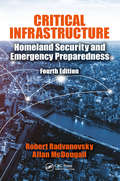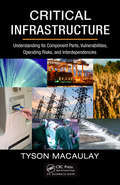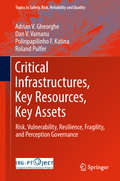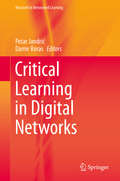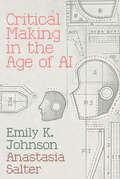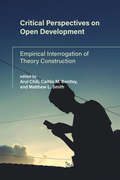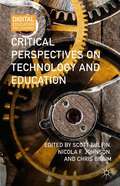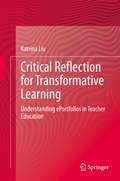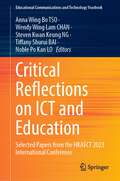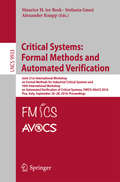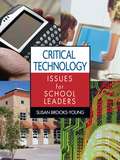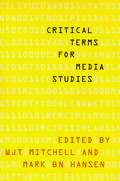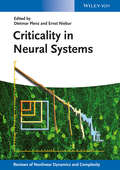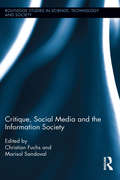- Table View
- List View
Critical Infrastructure: Homeland Security and Emergency Preparedness
by Robert Radvanovsky Allan McdougallCritical Infrastructure: Homeland Security and Emergency Preparedness, Fifth Edition represents a continuation of research and recommendations from the past editions that spans nearly twenty years of focusing on critical infrastructure (CI) protection. Over that time, the operating, threat, and technical environments have changed drastically. The doctrines that have guided practitioners across various domains have also evolved due to changing demands. This is a natural result when doctrines collide and gradually evolve toward, and coalesce into, a singular understanding of an issue. Those who have practiced in this domain have seen these collisions in the past - an example being the convergence of physical security and cyber information and operational) technologies security. It is with this backdrop and understanding of the domain that the authors not only describe the current state of affairs, but also provide a means through which researchers and participants - such as practitioners, students, industry stakeholders, owners, and operators in various government and private CI sectors - can look at trends and changes the in the domain that may not be apparent elsewhere. The authors identify shifts in today’s environment that move the thinking away from simply the robustness of systems to their adaptability and resilience. They outline design processes that, likewise, are evolving away from the simple adoption of best practices to risk-based management and even towards structures based on engineering-driven principles. These changes are not occurring at a unified pace and the differences can result in tensions between certain communities. However, the debate itself is indicative of the critical thinking that is beginning to take hold within each infrastructure domain. Critical Infrastructure, Fifth Edition continues to critically examine the evolving importance of our critical infrastructure to our society - recognizing the underpinning value of cyber technology and how physical infrastructures and delivery models impact and affect people and society.
Critical Infrastructure: Homeland Security and Emergency Preparedness,
by Robert S. Radvanovsky Allan McDougallThis edition of Critical Infrastructure presents a culmination of ongoing research and real-work experience, building upon previous editions. Since the first edition of this work, the domain has seen significant evolutions in terms of operational needs, environmental challenges and threats – both emerging and evolving. This work expands upon the previous works and maintains its focus on those efforts vital to securing the safety and security of populations. The world continues to see a shift from a force-protection model to one more focused on resilience. This process has been exacerbated and challenged as societies face increased instability in weather and arguably climate, a destabilized geopolitical situation, and continuing economic instability. Various levels—ranging from international oversight to individual actions—continue to work towards new approaches and tools that can assist in meeting this challenge. This work keeps pace with the key changes that have occurred since previous editions and continues to provide insight into emerging and potential issues. Expanding from historical research, major areas of interest such as climate change, regulatory oversight, and internal capacity building are explored. This work provides a reference for those that are working to prepare themselves and their organizations for challenges likely to arise over the next decade. In keeping with the fast-changing nature of this field, Critical Infrastructure: Homeland Security and Emergency Preparedness, Fourth Edition has been completely revised and fully updated to reflect this shift in focus and to incorporate the latest developments. Presents an overview of some of the emerging challenges and conflicts between the public and private sector; Continues to build the case for organizations to adopt an intelligence-driven and adaptive approach to protecting infrastructure; Presents a unique and new perspective of re-examining baseline requirements against a range of shifting factors, taking a balanced approach between risk-based planning and consequence management; Expands upon the issue of internal and lone-wolf threats that pose additional challenges to a system that continues to focus largely on external threats; and An enhanced and improved view of interdependencies in an increasingly inter-connected and network-enabled world. Preparing for the challenges of increasingly unstable threat and operating environments will pose challenges at all levels. Those involved in ensuring that critical infrastructure protection and assurance efforts function effectively and efficiently—whether as government regulators, business operators, clients of various infrastructure sectors or those seeking to maintain an accountable system – will find insights into less-explored aspects of this challenging field.
Critical Infrastructure: Understanding Its Component Parts, Vulnerabilities, Operating Risks, and Interdependencies
by Tyson MacaulayCritical Infrastructure (CI) is fundamental to the functioning of a modern economy, and consequently, maintaining CI security is paramount. However, despite all the security technology available for threats and risks to CI, this crucial area often generates more fear than rational discussion. Apprehension unfortunately prompts many involved in CI p
Critical Infrastructures, Key Resources, Key Assets: Risk, Vulnerability, Resilience, Fragility, and Perception Governance (Topics in Safety, Risk, Reliability and Quality #34)
by Adrian V. Gheorghe Polinpapilinho F. Katina Dan V. Vamanu Roland PulferIn the face of increasing failures, comments attributed to Albert Einstein loom large: "We cannot solve our problems with the same thinking we used when we created them. " There is a pervasive feeling that any attempt to make sense of the current terrain of complex systems must involve thinking outside the box and originating unconventional approaches that integrate organizational, managerial, social, political, cultural, and human aspects and their interactions. This textbook offers research-based models and tools for diagnosing and predicting the behavior of complex techno-socio-economic systems in the domain of critical infrastructures, key resources, key assets and the open bazaar of space, undersea, and below-ground systems. These models exemplify emblematic models in physics, within which the critical infrastructures, as well as society itself and its paraphernalia, share the profile of many-body systems featuring cooperative phenomena and phase transitions - the latter usually felt as disruptive occurrences. The book and its models focus on the analytics of real-life-business actors, including policy-makers, financiers and insurers, industry managers, and emergency responders.
Critical Learning in Digital Networks (Research in Networked Learning)
by Petar Jandrić Damir BorasThis ambitious multidisciplinary volume assembles diverse critical-theory approaches to the current and future states of networked learning. Expert contributors expand upon the existing literature by analyzing the ethical aspects of networked learning and the ongoing need for more open, inclusive, and socially engaged educational practice. Chapters explore in depth evolving concepts of real and virtual, the processes of learning in, against, and beyond the internet, and the role of critical pedagogy in improving social conditions. In all, coverage is both realistic and positive about the potential of digital technologies in higher education as well as social and academic challenges on the horizon. Included among the topics: Counting on use of technology to enhance learning. Decentralized networked learning through online pre-publication. The reality of the online teacher. Moving from urban to virtual spaces and back. The project of a virtual emancipatory pedagogy. Using information technologies in the service of humanity. It is no longer a question of "Can technology enhance learning" it's a given that it does. Critical Learning in Digital Networks offers education researchers, teacher educators, instructional technologists, and instructional designers tools and methods for strengthening this increasingly vital interconnection.
Critical Making in the Age of AI
by Anastasia Salter Emily JohnsonCritical Making in the Age of AI invites students, teachers, learners, and digital humanists to explore making as scholarship. Inspired by the craft traditions of textile arts, this book combines a survey of forms of alternative scholarly communication—such as comics, GIFs, maps, games, and generative AI—and a pattern book, where patterns serve as starting points that makers can reimagine and remix. Firmly grounded in the humanities and utilizing free tools and platforms (including Twine, Voyant, and Tracery) wherever possible, this engaging and accessible guide to digital methods introduces and puts into practice concepts that are essential to preparing students to navigate a changing landscape of media and information without investing in proprietary software, dedicated lab space, or expensive creative tools. The book’s eight patterns are especially appropriate for those just beginning to explore digital scholarly methods, and one goal of Critical Making in the Age of AI is to provide structure for work that is both meaningful and achievable with limited resources and time. By centering critical making through a design-justice and feminist lens, the coauthors model how inclusive and expansive approaches to making in research and teaching are vital to shaping the humanities of the future.
Critical Perspectives on Esports (ICSSPE Perspectives)
by Annette R. Hofmann Pascal Mamudou CamaraThis book offers new, multidisciplinary perspectives on esports, one of the most rapidly growing sectors in the sports and leisure industries.Drawing on sociology, philosophy, education, business, economics, and sports science, this book considers the rise of esports, its impact on sports and society more widely, and the direction of travel for esports in the future. Featuring cutting-edge work from researchers in Europe, North America, and Asia, this book explores definitions of “esport” and “virtual sport,” and the philosophical basis by which we understand movement and embodiment in the context of digital gaming. It considers the health and well-being needs of esports athletes, across physical, mental, and social dimensions, as well as how nutrition and training relate to performance and injury prevention. This book also considers the economics of the esports industry and how the concept of sportification can be used to describe esports’ development, as well as the challenges and debates surrounding gender and representation in esports. A final section of this book looks at esports in education, in schools and universities, and considers the future of esports for a generation of digital natives.This book makes a useful contribution to the growing body of knowledge on esports and should be a thought-provoking read for anybody with an interest in sports studies, gaming, or the impact of technology on wider society.
Critical Perspectives on Open Development: Empirical Interrogation of Theory Construction (International Development Research Centre)
by Arul Chib, Caitlin M. Bentley, and Matthew L. SmithTheoretical and empirical analyses of whether open innovations in international development instrumentally advantages poor and marginalized populations.Over the last ten years, "open" innovations--the sharing of information without access restrictions or cost--have emerged within international development. But do these practices instrumentally advantage poor and marginalized populations? This book examines whether, for whom, and under what circumstances the free, networked, public sharing of information and communication resources contributes (or not) towards a process of positive social transformation. The contributors offer both theoretical and empirical analyses that cover a broad range of applications, emphasizing the underlying aspects of open innovations that are shared across contexts and domains.
Critical Perspectives on Technology and Education
by Chris Bigum Scott Bulfin Nicola F. JohnsonThis book offers critical readings of issues in education and technology and demonstrates how researchers can use critical perspectives from sociology, digital media, cultural studies, and other fields to broaden the "ed-tech" research imagination, open up new topics, ask new questions, develop theory, and articulate an agenda for informed action.
Critical Play: Radical Game Design
by Mary FlanaganAn examination of subversive games—games designed for political, aesthetic, and social critique.For many players, games are entertainment, diversion, relaxation, fantasy. But what if certain games were something more than this, providing not only outlets for entertainment but a means for creative expression, instruments for conceptual thinking, or tools for social change? In Critical Play, artist and game designer Mary Flanagan examines alternative games—games that challenge the accepted norms embedded within the gaming industry—and argues that games designed by artists and activists are reshaping everyday game culture. Flanagan provides a lively historical context for critical play through twentieth-century art movements, connecting subversive game design to subversive art: her examples of “playing house” include Dadaist puppet shows and The Sims. She looks at artists' alternative computer-based games and explores games for change, considering the way activist concerns—including worldwide poverty and AIDS—can be incorporated into game design.Arguing that this kind of conscious practice—which now constitutes the avant-garde of the computer game medium—can inspire new working methods for designers, Flanagan offers a model for designing that will encourage the subversion of popular gaming tropes through new styles of game making, and proposes a theory of alternate game design that focuses on the reworking of contemporary popular game practices.
Critical Reflection for Transformative Learning: Understanding e-Portfolios in Teacher Education
by Katrina LiuThis book provides a research-based guide to using ePortfolios to develop critically reflective teachers capable of transformative learning for educational equity. It begins with a conceptualization of critical reflection in teacher education, then analyzes the social discourse of prospective teachers' teaching practice through their ePortfolio reflections, triangulated by classroom teaching observations and interviews. The results of the research show that prospective teachers’ reflections are performative and do not typically trigger transformative learning, in large part because of discrepancies in the structures of the ePortfolio, the goals of the teacher education program, and the mentoring and supervisory practices. With this analysis in hand, the book turns to practical questions, providing a transformative framework along with examples and tips for teacher educators to use the author’s methods to understand and analyze prospective teachers’ reflection and support their transformative learning.
Critical Reflections on Career Education and Guidance: Promoting Social Justice within a Global Economy
by Barrie A. Irving Beatriz MalikFirst Published in 2004. Routledge is an imprint of Taylor & Francis, an informa company.
Critical Reflections on ICT and Education: Selected Papers from the HKAECT 2023 International Conference (Educational Communications and Technology Yearbook)
by Anna Wing Bo TSO Steven Kwan Keung NG Tiffany Shurui Bai Wendy Wing Lam CHAN Noble Po Kan LOThis book includes selected papers from the Hong Kong Association for Educational Communications and Technology (HKAECT) 2023 International Conference. It provides readers with a collection of insightful chapters which delves into the realms of data visualization, artificial intelligence (AI), virtual reality (VR), and augmented reality (AR). It also reflects on the dynamic shifts in online learning, blended learning, and self-directed learning. Part one of the volume includes case studies and examples of the integration of advanced technologies, such as data visualization, generative AI, and mixed reality in education. Part two shares experiences and observations from educators who embrace online learning, blended learning, and independent learning. Part three investigates the influences digital education has on learning, teaching, and society as a whole. The book paves a path for thought-provoking discussions on the future of education in a digitally connected world. It is a vital resource for educators, administrators, policymakers, and learners seeking to navigate and thrive in the rapidly evolving world of digital education.
Critical Security Controls for Effective Cyber Defense: A Comprehensive Guide to CIS 18 Controls
by Dr. Jason EdwardsThis book is an essential guide for IT professionals, cybersecurity experts, and organizational leaders navigating the complex realm of cyber defense. It offers an in-depth analysis of the Critical Security Controls for Effective Cyber Defense, known as the CIS 18 Controls, which are vital actions for protecting organizations against prevalent cyber threats. The core of the book is an exhaustive examination of each CIS 18 Control. Developed by the Center for Internet Security (CIS), these controls are the benchmark in cybersecurity, crafted to counteract the most common and impactful cyber threats. The book breaks down these controls into comprehensible segments, explaining their implementation, management, and effectiveness. This detailed approach is crucial in the context of the digital era's evolving cyber threats, heightened by the rise in remote work and cloud-based technologies. The book's relevance is magnified by its focus on contemporary challenges, offering strategies to strengthen cyber defenses in a fast-paced digital world. What You Will Learn Implementation Strategies: Learn detailed strategies for implementing each of the CIS 18 Controls within your organization. The book provides step-by-step guidance and practical insights to help you integrate these controls effectively, ensuring that your cyber defenses are robust and resilient. Risk Mitigation Techniques: Discover how to identify and mitigate risks associated with failing to implement these controls. By understanding the potential consequences of neglecting each control, you can prioritize actions that protect your organization from the most significant threats. Actionable Recommendations: Access practical, actionable recommendations for managing and maintaining these controls. The book offers clear and concise advice on how to continuously improve your cybersecurity measures, adapting to evolving cyber threats and organizational needs to ensure long-term protection. Training and Simplification: Explore recommended training programs and simplified security control measures that can be tailored to fit the specific needs and challenges of your business environment. This section emphasizes the importance of ongoing education and streamlined processes to enhance your organization's overall cybersecurity readiness. Importance and Relevance: Understand the importance and relevance of each CIS 18 Control in the context of contemporary cybersecurity challenges. Learn why these controls are crucial for safeguarding your organization against the most prevalent cyber threats. Key Concepts and Terms: Familiarize yourself with the key concepts and terms associated with each CIS 18 Control. This foundational knowledge will help you communicate more effectively with stakeholders and ensure a common understanding of cybersecurity principles. Questions to Ask: Discover the critical questions you should ask when assessing your organization’s implementation of each control. These questions will guide your evaluation and help identify areas for improvement. Who This Book Is For IT and cybersecurity professionals, business leaders and executives, small business owners and managers, students and academics in cybersecurity fields, government and on-profit sector professionals, and cybersecurity consultants and trainers
Critical Systems Thinking: A Practitioner's Guide
by Michael C. JacksonCRITICAL SYSTEMSTHINKING Understand the full range of systems approaches and how to use them with this innovative overview. Leaders and managers face increasing complexity and uncertainty because technical, organizational, socio-cultural, political, and environmental issues have become intensely interconnected. Systems thinking is recognized as the essential competence for managing complexity. As the demand for systems thinking grows, however, the fragmentation of the field into different methodologies has become a potential liability. Critical systems thinking (CST) shows how this diversity can be a strength rather than a weakness by revealing how different systems methodologies address various aspects of complexity and how they can be used in combination to resolve the messiest of wicked problems. Critical Systems Thinking offers, in a single volume, an account of the value of systems thinking and CST in the modern world, an explanation of the pragmatic philosophy and expansion in mindset necessary to embrace CST, and detailed instructions on how to undertake critical systems practice (CSP) using the variety of systems approaches to navigate multi-dimensional complexity. Readers will find: An accessible introduction to systems thinking and CST. A description and critique of the best-known systems methodologies. A guide to the mindset changes, the steps required, and the toolkit necessary to undertake successful CSP. Case studies and examples of CSP. A discussion of the nature of systemic leadership. Critical Systems Thinking is ideal for leaders and managers in government, business, the public sector, the professions, and beyond who want to understand the potential of systems thinking and use it in their work. It is essential for systems researchers and practitioners who want a deeper understanding of the field.
Critical Systems: Joint 21st International Workshop on Formal Methods for Industrial Critical Systems and 16th International Workshop on Automated Verification of Critical Systems, FMICS-AVoCS 2016, Pisa, Italy, September 26-28, 2016, Proceedings (Lecture Notes in Computer Science #9933)
by Stefania Gnesi Alexander Knapp Maurice H. ter BeekThis book constitutes the refereed proceedings of the Joint 21st International Workshop on Formal Methods for Industrial Critical Systems and the 16th International Workshop on Automated Verification of Critical Systems, FMICS-AVoCS 2016, held in Pisa, Italy, in September 2016. The 11 full papers and 4 short papers presented together with one invited talk were carefully reviewed and selected from 24 submissions. They are organized in the following sections: automated verification techniques; model-based system analysis; and applications and case studies.
Critical Systems: Joint 22nd International Workshop on Formal Methods for Industrial Critical Systems and 17th International Workshop on Automated Verification of Critical Systems, FMICS-AVoCS 2017, Turin, Italy, September 18–20, 2017, Proceedings (Lecture Notes in Computer Science #10471)
by Laure Petrucci Cristina Seceleanu Ana CavalcantiThis book constitutes the refereed proceedings of the Joint 22nd International Workshop on Formal Methods for Industrial Critical Systems and the 17th International Workshop on Automated Verification of Critical Systems, FMICS-AVoCS 2017, held in Turin, Italy, in September 2017. The 14 full papers presented together with one invited talk were carefully reviewed and selected from 30 submissions. They are organized in the following sections: Automated verification techniques; Testing and scheduling; Formal Methods for mobile and autonomous robots; and Modeling and analysis techniques.
Critical Technology Issues for School Leaders
by Dr Susan J. Brooks-YoungThis resource helps school leaders focus on critical technology leadership issues and practical solutions for integrating technology into any school, administration, or professional development program.
Critical Terms for Media Studies
by W. J. T. Mitchell Mark HansenCommunications, philosophy, film and video, digital culture: media studies straddles an astounding array of fields and disciplines and produces a vocabulary that is in equal parts rigorous and intuitive. Critical Terms for Media Studiesdefines, and at times, redefines, what this new and hybrid area aims to do, illuminating the key concepts behind its liveliest debates and most dynamic topics. Part of a larger conversation that engages culture, technology, and politics, this exciting collection of essays explores our most critical language for dealing with the qualities and modes of contemporary media. Edited by two outstanding scholars in the field, W.J.T. Mitchell and Mark B.N. Hansen, the volume features works by a team of distinguished contributors.
Critical Theory of AI
by Simon LindgrenWe live in an age of artificial intelligence. Machines think and act in ever more complex ways, making suggestions and decisions on our behalf. While AI might be seen as practical and profitable, issues of data surveillance, algorithmic control, and sexist and racist bias persist. In this rapidly changing landscape, social analysis of AI risks getting scaled down to issues of ‘ethics’, ‘responsibility’, and ‘fairness’. While these are important issues, they must be addressed not from an ‘AI first’ perspective, but more thoroughly in terms of power and contention. Approaching artificial intelligence from the often overlooked perspective of critical social theory, this book provides a much-needed intervention on how both old and new theories conceptualize the social consequences of AI. Questions are posed about the ideologies driving AI, the mythologies surrounding AI, and the complex relationship between AI and power. Simon Lindgren provides a way of defining AI as an object of social and political critique, and guides the reader through a set of contentious areas where AI and politics intersect. In relation to these topics, critical theories are drawn upon, both as an argument for and an illustration of how AI can be critiqued. Given the opportunities and challenges of AI, this book is a must-read for students and scholars in the humanities, social sciences, and STEM disciplines.
Critical, Transdisciplinary and Embodied Approaches in STEM Education (Advances in STEM Education)
by Pratim Sengupta Marie-Claire Shanahan Beaumie KimOver the past decade, integrated STEM education research has emerged as an international concern, creating around it an imperative for technological and disciplinary innovation and a global resurgence of interest in teaching and learning to code at the K-16 levels. At the same time, issues of democratization, equity, power and access, including recent decolonizing efforts in public education, are also beginning to be acknowledged as legitimate issues in STEM education. Taking a reflexive approach to the intersection of these concerns, this book presents a collection of papers making new theoretical advances addressing two broad themes: Transdisciplinary Approaches in STEM Education and Bodies, Hegemony and Decolonization in STEM Education. Within each theme, praxis is of central concern including analyses of teaching and learning that re-imagines disciplinary boundaries and domains, the relationship between Art and STEM, and the design of learning technologies, spaces and environments. In addition to graduate research seminars at the Masters and PhD levels in Learning Sciences, Science Education, Educational Technology and STEM education, this book could also serve as a textbook for graduate and pre-service teacher education courses.
Criticality in Neural Systems
by Heinz Georg Schuster Dietmar Plenz Ernst NieburLeading authorities in the field review current experimental and theoretical knowledge oncriticality and brain function.The book begins by summarizing experimental evidence for criticality and self-organizedcriticality in the brain. Subsequently, important breakthroughs in modeling of critical neuronal circuits and how to establish self-organized criticality in the brain are described.A milestone publication, defining upcoming directions of research in this new fi eld and set to become the primary source of information on the brain and criticality.
Critique, Social Media and the Information Society (Routledge Studies in Science, Technology and Society)
by Christian Fuchs Marisol SandovalIn times of global capitalist crisis we are witnessing a return of critique in the form of a surging interest in critical theories (such as the critical political economy of Karl Marx) and social rebellions as a reaction to the commodification and instrumentalization of everything. On one hand, there are overdrawn claims that social media (Twitter, Facebook, YouTube, etc) have caused uproars in countries like Tunisia and Egypt. On the other hand, the question arises as to what actual role social media play in contemporary capitalism, crisis, rebellions, the strengthening of the commons, and the potential creation of participatory democracy. The commodification of everything has resulted also in a commodification of the communication commons, including Internet communication that is today largely commercial in character. This book deals with the questions of what kind of society and what kind of Internet are desirable, how capitalism, power structures and social media are connected, how political struggles are connected to social media, what current developments of the Internet and society tell us about potential futures, how an alternative Internet can look like, and how a participatory, commons-based Internet and a co-operative, participatory, sustainable information society can be achieved.
Cross Over to HTML5 Game Development: Use Your Programming Experience to Create Mobile Games
by Zarrar ChishtiBreak into the most lucrative platform in the world by adding HTML5 game development to your current skillset. Zarrar Chishti has trained developers from a wide range of programming disciplines to cross over into HTML5 game development. Whatever your vocation, whether it be an Application Databases Systems developer or a Professional Web developer, with this book you will learn to evolve your current coding skills to become eligible for the biggest gaming platform in the world. From the first chapter you will see encouraging results immediately as you power through a challenging and fun project that has been uniquely designed and developed for this book. With the relentless backing of the giants of the industry including Apple and Google, HTML5 is rapidly becoming the leading technology for game development. Furthermore nearly every mobile device, tablet and PC system offer full support to the latest games developed in HTML5. Never before has there been such a widely accepted platform by literally every manufacturer and operating system. This in turn has convinced marketing departments to move away from traditional platforms, such as dedicated mobile apps, for the more widely accepted HTML5 format. There has never been a better time for a seasoned IT programmer to crossover and capitalize in this lucrative market with their much sought after talents and experience. Take the skills you already have and expand your career into HTML5 development with this book. What You'll Learn Quickly identify the core similarities and differences between HTML5 and other coding standards Follow a large scale game development project to experience the full lifecycle of an HTML5 game development project Download graphics and media to use in sample projects throughout the book Who This Book Is For Professional developers working in application and database development. These seasoned coders, having secured a wealth of knowledge, can transfer that expertise to the growing HTML5 game development market. This book will instantly appeal to this audience as it will not attempt to teach the basics of programming; instead it will simply point out the differences in how to develop with HTML5.
Cross Reality and Data Science in Engineering: Proceedings of the 17th International Conference on Remote Engineering and Virtual Instrumentation (Advances in Intelligent Systems and Computing #1231)
by Michael E Auer Dominik MayToday, online technologies are at the core of most fields of engineering and society as a whole . This book discusses the fundamentals, applications and lessons learned in the field of online and remote engineering, virtual instrumentation, and other related technologies like Cross Reality, Data Science & Big Data, Internet of Things & Industrial Internet of Things, Industry 4.0, Cyber Security, and M2M & Smart Objects.Since the first Remote Engineering and Virtual Instrumentation (REV) conference in 2004, the event has focused on the use of the Internet for engineering tasks, as well as the related opportunities and challenges. In a globally connected world, interest in online collaboration, teleworking, remote services, and other digital working environments is rapidly increasing. In this context, the REV conferences discuss fundamentals, applications and experiences in the field of Online and Remote Engineering as well as Virtual Instrumentation. Furthermore, the conferences focus on guidelines and new concepts for engineering education in higher and vocational education institutions, including emerging technologies in learning, MOOCs & MOOLs, and open resources.This book presents the proceedings of REV2020 on “Cross Reality and Data Science in Engineering” which was held as the 17th in series of annual events. It was organized in cooperation with the Engineering Education Transformations Institute and the Georgia Informatics Institutes for Research and Education and was held at the College of Engineering at the University of Georgia in Athens (GA), USA, from February 26 to 28, 2020.

